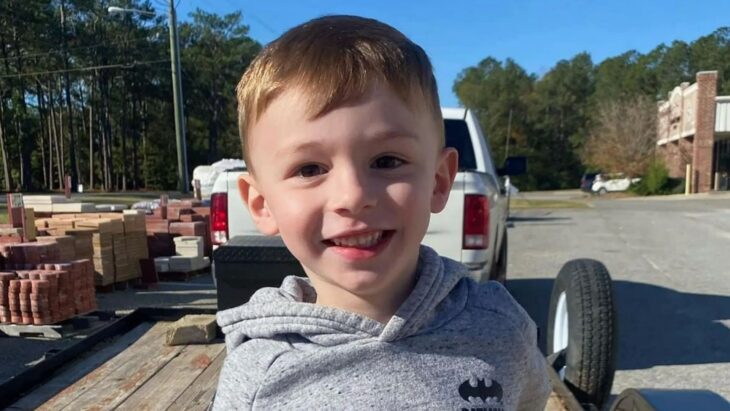
Boy’s ‘stinging nettle rash’ morphed into burns as toxic sap reacted with sunlight – forcing him to hide indoors
A TOT suffered such severe burns after a brush with “Britain’s most dangerous plant” that he must hide from sunlight for the rest of summer.
Autumn and Steven Mckown were on holiday in Dublin, Ireland, on Friday, April 19, with their four-year-old son Bentley for a softball game.
The youngster went off to play in the bushes with other children before emerging while scratching his left arm.
At first, the 27-year-old from Berkshire believed her son had stung himself on stinging nettles and thought “nothing of it”.
But when the family woke the next day, Bentley’s arm was covered in “big bubbled” blisters and red sores, Autumn said.
“I immediately started researching the types of plants found in Ireland online, and hogweed was the first thing that came up,” she added.
I have read stories where people have had it all over their body and had to be hospitalised for it
Autumn Mckown
Giant hogweed is a plant that carries a toxic sap that stops the skin from protecting itself against the sun’s rays, causing gruesome burns when exposed to natural light.
What is more, it often causes no immediate pain, meaning its victims can continue to burn in the sun, heedless of any problems.
The plant can spread its sap with only a moment’s exposure.
The mum-of-one claims Bentley’s skin may take months to heal and says she has been advised to keep him out of sunlight and to wear long-sleeved tops all summer.
“We play softball every weekend and love camping,” she explained.
“Bentley is also a boy and just wants to get out in the back garden with his t-shirt off and run around, so he can’t really do that [this summer].
“He’s a little aggravated that he can’t play in the water play at nursery at the moment.
“I’ve been researching recovery time, and it can take months to heal.
“Even after the blisters have popped and healed, you can be left with discolouration on your arm, which are very sensitive to sunshine.”
After being prescribed a steroid cream for his burns, Bentley will have to keep his arm bandaged for a few weeks as it begins to heal.
Autumn is keen to raise awareness of the plant’s dangers and wants parents to be more vigilant about where their children play.
“I will definitely be more vigilant of Bentley 1714467635,” she said.
“Obviously, kids can’t always be vigilant and know about these plants, but hogweed injuries can be very serious, and we’re lucky it was just on his arm.
“I have read stories where people have had it all over their body and had to be hospitalised for it.
She added: “My advice to parents would definitely be vigilant for your kids and look around the area where they’re playing before you let them.
“I will be more mindful before sending Bentley off to play.”
The giant hogweed is native to the Caucasus but was introduced to Britain as an ornamental plant in 1817, and its spread has now got out of control.
It was called “without a shadow of a doubt, the most dangerous plant in Britain” by Mike Duddy of the Mersey Basin Rivers Trust in 2015.
Everything you need to know about giant hogweeds
AN invasive species dubbed “Britain’s most dangerous plant
Giant Hogweed may look impressive but any contact with the sap of this plant can cause serious injury, particularly to your skin.
What does Giant Hogweed look like?
When fully grown, giant hogweed is aptly named.
The plant can grow up to 25ft tall, with long green stems, purple blotches, and huge branches of small white flowers and large green leaves.
The plant’s flower heads bloom in June and July and can reach up to 2ft across.
Giant hogweed can be mistaken for other plants such as cow parsley, cow parsnip, Queen Anne’s Lace or elderberry as the flowers look similar.
Their size when fully grown is very helpful for identifying the harmful crop.
Why does Giant Hogweed cause rashes, burns and blisters?
Giant hogweed stems have fine needle-like hairs that can cause extreme irritation.
While the sap in giant hogweed contains a chemical called furanocoumarins.
When this toxin comes into contact with the skin, it binds with DNA in skin cells, causing them to die.
The sap reacts with the melanin in your skin and removes protection that patch has from UV light, causing photosensitivity (where the affected area becomes highly sensitive to sunlight), resulting in nasty burns, lesions and blisters.
Those burns can last for several months and, even once they’ve gone, skin can remain scarred and sensitive to sunlight for years to come.
If the hairs of the giant hogweed plant or its sap come into contact with your eyes, they can even cause temporary or even permanent blindness in severe cases.
How do I treat burns from Giant Hogweeds?
The NHS website advises that if you come into contact with giant hogweed and you get a burn, you should wash the affected area with soap and water and then cover it, keeping it out of natural or artificial light.
If blisters appear, do not burst them! If the blisters are extensive, seek medical attention.
Should you get sap in your eye, flush the eye with a large amount of water and seek medical attention.
If you begin to feel unwell after contact with giant hogweed, speak to your doctor.
Ensure you thoroughly and quickly wash the clothes you were wearing when you came into contact with the plant.
And if you’re concerned that a child has come into contact with, or ingested giant hogweed, seek medical attention immediately
>






